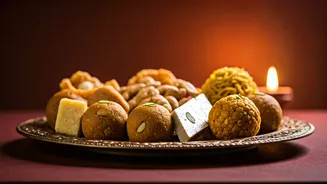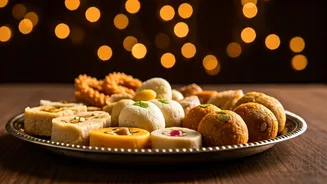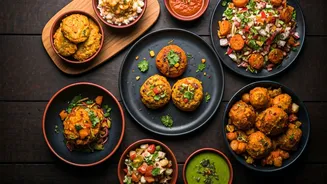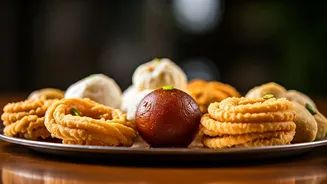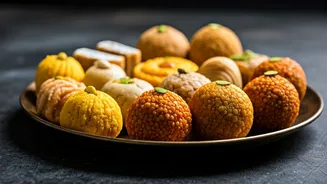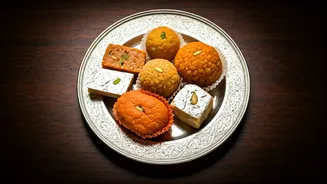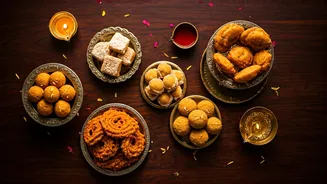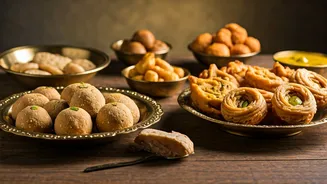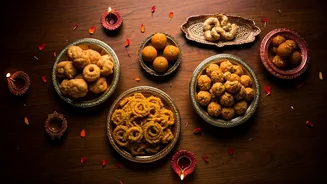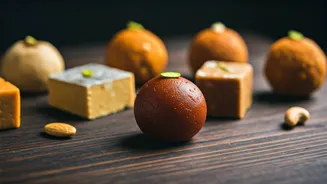Aloo Gobi's Charm
The first recipe to consider is the ever-popular Aloo Gobi. The combination of potatoes and cauliflower, simmered in a medley of aromatic spices, is a classic
for a reason. Begin by gently sautéing onions and ginger-garlic paste until they become translucent. Then, introduce the potatoes and cauliflower florets, ensuring they are well-coated with the spices like turmeric, coriander, and cumin. A touch of red chili powder adds a hint of heat. Allow the vegetables to cook until tender, stirring occasionally to prevent sticking. A final flourish of fresh coriander leaves adds freshness and visual appeal, making this dish a perfect side to your Diwali meal.
Palak Paneer Delight
Next on the list, is Palak Paneer – a creamy spinach and cottage cheese dish that is a favorite across India. Start by blanching fresh spinach leaves, then blend them into a smooth puree. In a separate pan, sauté onions, tomatoes, and spices like garam masala and ginger-garlic paste. Add the spinach puree, allowing it to simmer and thicken. Gently incorporate the paneer cubes, ensuring they are heated through. A dollop of cream at the end adds richness, enhancing the dish's flavor. Palak Paneer is not just delicious; it’s also packed with nutrients, making it a healthy and festive choice for Diwali.
Vegetable Biryani Bliss
For a dish that's both flavorful and filling, consider Vegetable Biryani. This dish involves layering fragrant basmati rice with a medley of vegetables. Start by marinating your favorite vegetables in yogurt and spices such as ginger-garlic paste, garam masala, and turmeric. Sauté onions and tomatoes separately, then assemble the biryani in a heavy-bottomed pot. Alternate layers of rice and vegetables, adding mint leaves and coriander for aroma. The final step involves slow cooking or ‘dum’ cooking the biryani, trapping the steam and allowing the flavors to meld. Vegetable Biryani is a complete meal in itself, perfect for a festive gathering.
Dal Makhani Comfort
No Diwali feast is complete without Dal Makhani. This slow-cooked lentil dish is incredibly rich and comforting. The recipe begins with soaking black lentils overnight. Then, slow-cook the lentils with kidney beans in a pressure cooker until they are soft and creamy. Sauté onions, tomatoes, and ginger-garlic paste. Combine these with the cooked lentils. A generous amount of butter and cream is added, allowing the dish to simmer and develop its flavor. Dal Makhani, with its subtle spices and velvety texture, offers a comforting warmth, making it an essential part of the Diwali menu.
Gulab Jamun Sweetness
Now it's time for the sweets! Gulab Jamun are perfect for satisfying your sweet tooth. Start by mixing milk powder, flour, and baking powder. Add a little milk and knead it into a soft dough. Shape small balls from the dough and deep fry them until golden brown. Then, prepare a sugar syrup flavored with cardamom and rose water. Soak the fried gulab jamuns in the warm syrup, allowing them to absorb the sweetness and become soft and spongy. Gulab Jamun, with their delightful sweetness and melt-in-your-mouth texture, are a festive indulgence everyone will love.
Kheer's Creamy Delight
Finally, consider making Kheer for a creamy and satisfying dessert option. Kheer, a traditional rice pudding, is simple to make but delivers a rich and comforting experience. Start by boiling rice in milk until the rice is soft and the milk thickens. Add sugar, cardamom, and nuts like almonds and pistachios. Stir constantly until the Kheer reaches a creamy consistency. Garnish with more nuts and saffron strands to elevate the presentation. Kheer's simple elegance makes it the perfect dessert to conclude your Diwali meal, providing a sweet end to a beautiful celebration.
